1 Introduction
The architecture of XBRL as defined in [XBRL 2.1] defines a rich set of syntactic and semantic rules
for specifying concepts that are members, or elements, of one dimension and relationships among them in what is
termed a "taxonomy" (plural "taxonomies"). It also defines extensibility mechanisms for taxonomies and
"Discoverable Taxonomy Sets" (or DTSs - see section 3.2). These rules employ XML Schemas [XML Schema Structures] [XML Schema Datatypes] to identify the various concepts
involved and XLINK linkbases [XLINK] to define relationships between those concepts and between
those concepts and other resources. It also defines a rich set of syntactic and semantic rules for how such DTSs
are to be referenced and interpreted when used in conjunction with an XBRL instance. XBRL also provides a
mechanism for instance preparers to define other dimensional metadata that describe facts that are reported in
the XBRL instance. This mechanism involves the notion of "contexts" (defined by the <context>
element) and, within those <context> s, the use of <segment> and/or <scenario>
elements along with additional schemas that specify all dimensional metadata that is not otherwise given
semantic meaning by [XBRL 2.1]. Dimensions that ARE provided such semantic meaning by [XBRL 2.1] are the "time" dimension, which leverages the sophisticated semantic mechanisms provided in XML
Schema [XML Schema Structures], and, to a limited extent, "units" which may sometimes be viewed as
dimensional and at other times as properties of individual facts depending on the application.
The contents of the <segment> and <scenario> elements are deliberately left open to
permit users to fashion their own mechanisms for defining and referencing this dimensional metadata. It has,
however, become apparent in practice that there is a need to
formalise a consistent system for defining this dimensional metadata and a need to define a mechanism for
specifying not only the names of such metadata elements but also their interrelationships. It has also become
apparent that often the nature of such metadata and metadata relationships resembles very closely that which is
already addressed by the XBRL taxonomy mechanism which is used for the "concepts" dimension.
For the purposes defined in the Dimensional Taxonomies Requirements [Dimensions Requirements] this modular
extension to [XBRL 2.1] defines a formalisation of the syntax of the body of the <segment>
and <scenario> elements. This specification defines the syntax and semantics of dimensional taxonomies, which
in turn define the dimensions that MAY be used in an XBRL instance document. This
specification also defines the additional rules to which an XBRL instance document must adhere in order to be an
XBRL Dimensional Taxonomies (XDT) compliant instance document.
Dimensional taxonomies are syntactically identical to taxonomies that are defined in [XBRL 2.1] with certain restrictions that must be adhered to when they are to be used as dimensional taxonomies (see Section 2). In addition certain additional semantics are defined with respect to a taxonomy when it is used as a dimensional taxonomy and referenced as such by an XBRL instance.
All parts of this document not explicitly identified as non-normative are normative. In the event of any conflict or apparent conflict between the English language text of this document and/or schema fragments included in the main body of this document and the normative schemas contained herein, the more restrictive interpretation that is possible from the information provided by the English language text and that provided by the normative schemas SHALL prevail. The schema fragments incorporated into the body of the text are non-normative and are generally indicated as such by means of shading ( Section 1.4). The normative schemas do not necessarily always provide the most restrictive interpretation, either because it is not possible to express certain limitations using the syntax of XML Schema or because, as at the time of publication of this specification, some commonly available commercial implementations of XML Schema do not implement otherwise necessary features correctly or fully. The schemas and other documents published separately and contemporaneously with the specification are non-normative and are provided for the convenience of users of this specification.
1.1 Background
As should be apparent from the requirements [Dimensions Requirements], dimensional metadata was not invented
with XBRL. [XBRL 2.1] standardises the representation of only two dimensions: the time dimension and
the entity dimension. Many reporting purposes, both internal and external to organisations, require multiple
dimensions. What [XBRL 2.1] did create was the principles for this specification to exist while
defining two open elements in the <context> of XBRL instance documents: the <segment>
and <scenario> elements. This specification defines the syntax of elements that MAY
occur in the <segment> and <scenario> elements and defines standard arcs that
define the valid content of those elements. That content should be validated by dimensional XBRL processors
and standard errors are raised if the XBRL instance is not conformant with the multidimensional model defined
in the taxonomy. This specification uses three possible different roles that taxonomies can play in
representing multidimensional information: primary taxonomies, domain member taxonomies, and template
taxonomies. This taxonomy role differentiation is only illustrative. Because the multidimensional information
is represented by arcs and XBRL concepts and there is no way in XBRL to specify the role of a taxonomy, it is
possible for one taxonomy to play two or all of these roles simultaneously. The differentiation in this
specification provides an architectural framework to projects that incorporate multidimensional information
into existing taxonomies.
1.1.1 Primary taxonomies
A primary taxonomy is the DTS of an XBRL taxonomy that has no dimensional elements and no arcs defined in this specification. Requirement G16 states "Taxonomy authors MUST be able to extend a base taxonomy that does not have dimensional information, to have dimensions, without changing the concepts in the base." This specification uses the term primary taxonomy for a DTS of elements that MAY be instantiated in an XBRL instance. For example, a taxonomy used for external financial reporting MAY be extended with a variety of dimensional taxonomies appropriate to the reporting purpose.
1.1.2 Domain members taxonomies
Typed dimensional taxonomies as defined in Requirement G03 define syntactic constraints on the contents of segments and scenarios.
Explicit dimensional taxonomies are those in which the XBRL items form a discrete, countable finite
partitioning of a set of members, which hereafter is
called a domain. Examples include a taxonomy on the domain of geographic territories, or a taxonomy on a
domain of product lines. Inclusion relationships ( Requirement G09) are represented
by domain-member relationships. XBRL instances MAY use any number of
dimensional taxonomies, with the members of their domains possibly appearing in a variety of combinations
within XBRL <segment> and <scenario> elements.
1.1.3 Template taxonomies
The DTS of an instance using dimensional information MAY contain
domain-member relationships among items in both primary taxonomies and domain members
taxonomies. Since a primary taxonomy typically does not have dimensional information, this implies that
the instance-rooted DTS MUST contain domain-member relationships in a
linkbase that is not in the schema-rooted DTS of the primary taxonomy.
A template taxonomy imports all domain member taxonomies and primary taxonomies and adds the dimensional structures that will be used in the XBRL instance. By convention, a taxonomy that imports primary and domain member taxonomies and defines all the necessary dimensional information is called a template taxonomy. In particular, a template defines Hypercube. A Hypercube describes the Cartesian product of zero or more dimensions. Each dimension in turn is defined over zero or more domains and domains are composed of members. Note that in this formulation, a hypercube of a Primary Item does not include the Primary Item itself.
- Example: a topographic map is a 3-dimensional hypercube; it has thee dimensions - elevation, longitude and latitude - all of which are defined over the domain of real numbers. The elevation can be represented as a Primary Item, with longitude and latitude being the two dimensions of a hypercube for that Primary Item.
- Example: A table in a financial statement showing revenue by products and by territory, is a 3- dimensional hypercube, with one Primary Item (revenue) and two explicit dimensions (products and territory).
- Example: A loan report for a bank may be, in effect, an n-dimensional hypercube with dimensions including loan size (a Primary Item), borrower's credit rating, loan maturity, borrower type, loan purpose, and other dimensions.
The purpose of a template taxonomy is to define the structure of the hypercubes and link the hypercubes with the Primary Item.
1.2 Relationship to other work
This document pertains to XBRL as defined in the XBRL Specification.
Parts of this document may reiterate for expository clarity certain syntactic and semantic restrictions imposed by XBRL, but this document does not modify XBRL. In the event of any conflicts between this document and XBRL, XBRL prevails. This document does place additional restrictions beyond those prescribed by XBRL.
This document implements the business requirements agreed in the Domain Working Group of the XBRL consortium and documented in the [Dimensions Requirements] document.
1.3 Terminology (non-normative)
Terminology used in XBRL frequently overlaps with terminology from other fields.
| Term | Meaning (non-normative) |
|---|---|
| Arc, arcroleRef, base set, child, concept, context, duplicate item, descendant, DTS ( discoverable taxonomy set), element, entity, fact, instance, item, linkbase, linkbaseRef, p-equal, roleRef, taxonomy, taxonomy schema, u-equal, XBRL instance | As defined by [XBRL 2.1]. |
| relationship | An arc defines a relationship between its source concepts and target concepts that is determined by
its @xlink:arcrole and other attributes.
|
| source [concept(s)] | The concepts identified by the URI content of the @href attributes of the locator-type
elements in the same extended-type link element, which have the same label attribute content as the
content of the @from attribute of an arc.
|
| target [concept(s)] | The concepts identified by the URI content of the @href attributes of the locator-type
elements in the same extended-type link element, which have the same label attribute content as the
content of the @to attribute of an arc.
|
| MUST , MUST NOT , REQUIRED, SHALL, SHALL NOT, SHOULD , SHOULD NOT , RECOMMENDED, MAY , and OPTIONAL | As described in [IETF RFC 2119]. |
| XDT Compliant (XDT-compliant) | Describes an element, attribute, linkbase, schema, instance document or DTS satisfying all applicable mandatory ( MUST ) rules in this document. Any of such artefacts that violates or ignores a recommended ( SHOULD ) rule is inferior to one that obeys it and SHOULD NOT be emulated. |
| XBRL | Extensible Business Reporting Language [XBRL 2.1]. |
| XBRL valid | XML instances and schemas that satisfy the syntax requirements of [XBRL 2.1]. |
| Dimension | Each of the different aspects by which a fact MAY be characterised. A dimension
has only one effective domain. A typical example of a
dimension is the "product" dimension that identifies for a concept (Sales) the domain consisting of the
possible products that its fact can be expressed about. Dimensions are abstract elements in the
substitution group of xbrldt:dimensionItem.
|
| Domain | A (possibly empty or possibly infinite) set of members. A typical example could be the Longitude and Latitude dimensions. The numbers from -180 to +180 are a domain. In this case, both dimensions have the same domain. (In real life longitude is in a domain from -90 to +90 and latitude is in a domain from -180 to +180, but we are assuming both are the same for demonstration purposes only). |
| Effective Domain | A dimension which MAY have multiple dimension-domain relationships; the effective domain is the conjoint set of all related domains. |
| Domain Member / Valid Member | Each one of the possibilities in the domain of a Dimension. Explicit domains are defined by
domain-member relations. Example: In the "Products Dimension" an explicit domain can be created with
each one of the products as a domain-member. Domain member items are in the substitution group of
xbrli:item. |
| Explicit Dimension | Occurs when the domain explicitly names its members. The "Products Dimension" in the example above could be an explicit dimension. Explicit dimensions are defined by dimension-domain relations. |
| Typed Dimension | Occurs when the number of members is impractically large to enumerate explicitly. The "Longitude and Latitude" dimensions in the example above are typed dimensions because the domain is made of the infinite numbers in the range of -180 and +180. |
| Empty Dimension | An explicit dimension with no domain. |
| Primary Item | An [XBRL 2.1] item. |
| Primary Item Declaration | The declaration of [XBRL 2.1] item in a taxonomy. |
| Primary Item Descendant | Any child, grand-child etc. of a Primary Item according to the domain-member relationship. |
| Primary Taxonomy | A taxonomy that contains Primary Items. |
| Dimensional Taxonomy | A taxonomy whose schema-rooted DTS includes a definition linkbase with one or more arcs defined in this specification. |
| Template Taxonomy | A taxonomy that defines hypercubes and the relationships between the hypercubes and Primary Items. |
| Hypercube | A hypercube represents a set of dimensions. Hypercubes are abstract elements in the substitution
group of hypercubeItem that participate in has-hypercube relations and
hypercube-dimension relations.
|
| Empty Hypercube | A hypercube with no dimensions. |
| Hypercube Declaration | The declaration of a hypercube in a schema document. This is represented by an abstract element
declaration in the xbrldt:hypercubeItem substitution group |
| Dimension Declaration | The declaration of a dimension in a schema document. This is represented by an abstract element
declaration in the xbrldt:dimensionItem substitution group |
| Typed Dimension Element | The non XBRL
element
used in the <segment> or <scenario> element of a <context> as the dimension
identifier.
|
| Dimensional Relationship Set | A set of relationships constructed by traversing relationships (as described in Section 2.4) not only within base sets but across base sets, thus possibly including relationships from extended-type links with different roles, and relationships with different arc roles. |
| Base Set | As defined in 3.5.3.9.7.3 Networks of relationships in a DTS in [XBRL 2.1]. |
| Dimensional Processor | A processor that consumes XBRL dimensional instance documents or taxonomies and checks the conformance of that input document according to the rules declared in this document. |
| Raise an Error | The phrase "a dimensional processor MUST raise an error" means that a dimensional processor MUST signal something to the consuming application that is calling the validation process. The specific type of signal is application dependent. An example of how [XPATH 2.0] signals its errors can be seen in http://www.w3.org/TR/xquery-operators/#func-error . |
1.4 Document conventions
The following highlighting is used to present normative technical material in this document:
The following highlighting is used to present non-normative examples in this document:
The following highlighting is used to present non-normative counterexamples (examples of poor, discouraged or disallowed usage) in this document:
Non-normative editorial comments are denoted as follows and removed from final recommendations:
1.5 Namespaces
This table contains all the prefixes used within the text and the correspondent namespace URI:
| Prefix | Namespace URI |
|---|---|
xbrldt
|
http://xbrl.org/2005/xbrldt
|
xbrldi
|
http://xbrl.org/2006/xbrldi
|
xbrldte
|
http://xbrl.org/2005/xbrldt/errors
|
xbrldie
|
http://xbrl.org/2005/xbrldi/errors
|
xbrli
|
http://www.xbrl.org/2003/instance
|
xs
|
http://www.w3.org/2001/XMLSchema
|
xlink
|
http://www.w3.org/1999/xlink
|
link
|
http://www.xbrl.org/2003/linkbase
|
The Prefix column in the table above is non normative. The Namespace URI column is normative.
2 Dimensional Taxonomies
2.1 Architecture
In XBRL Instances, certain elements defined by this specification are distinguished by the use of elements
in the namespace http://xbrl.org/2006/xbrldi which is conventionally prefixed
xbrldi. These elements appear within the <scenario> and
<segment> elements only. XBRL instances are validated according to the syntax constraints implied
by typed dimensions (which require XML Schema validation and
nothing more) and by explicit dimensions (which require
description of each member element and relationships among the members using linkbases).
Dimensional taxonomies are distinguished by the use of several arc roles. These arc roles and their associated attribute declarations are in the
appinfo section of an XML schema.
The namespace of the schema is http://xbrl.org/2005/xbrldt. The prefix xbrldt is
used in this document to refer to elements and attributes defined in that schema.
Dimensional taxonomies MAY import the xbrldt schema and MUST be schema valid according to schema rules defined in [XML Schema Structures] and [XML Schema Datatypes]. Dimensional taxonomies according to this specification MUST also be valid [XBRL 2.1] taxonomies.
XBRL instances using the elements defined in xbrldi-2006.xsd MUST be XML Schema valid according to validation rules defined in [XML Schema Structures] and [XML Schema Datatypes]. XBRL instances whose DTS includes
dimensional taxonomies MUST be also valid instances according to [XBRL 2.1].

Figure 1
schematically shows the various relationships and the type of elements at their source and target, and the
purpose that these elements serve either as Primary Items, explicit
domain members, or as the root item that represents an entire dimension (typed or explicit). These
relationships need not all be within the same extended-type link element. The
@xbrldt:targetRole attribute is used to connect the different pieces from Primary Items to Members across multiple extended-type link elements. The
notation {all, notAll} means that there are two possible relationships. Additional attributes on
the element ( @abstract, @xbrldt:typedDomainRef)
or arc ( @xbrldt:closed, @xbrldt:usable and @xbrldt:contextElement) and their types are shown
on the arcs where they MAY appear.
[Def, 1] Primary item declarations are elements defined in XBRL taxonomies that are in the xbrli:item
substitution group and are not in the xbrldt:hypercubeItem or xbrldt:dimensionItem
substitution group.
Only XBRL items defined in the substitution group of xbrli:item MAY be used as an explicit dimension
member.
[Def, 2] Consecutive relationships are two relationships connected together according to the rules specified in Section 2.1.1.
[Def, 3] The Dimensional relationship set (DRS) is the set of consecutive relationships [Def, 2] that represents the relationships between a primary item declaration [Def, 1] and its multidimensional metadata. Figure 1 demonstrates a DRS.
The following sub-sections in this section each define a syntax component and its consequences for validation (its semantics) with positive and negative examples. The rules of syntax that apply to dimensional schemas, linkbases and instances are stated individually within each section.
2.1.1 Consecutive relationships
Two relationships MAY be consecutive. A pair of consecutive relationships consists of an initial relationship and a following relationship. For two relationships to be consecutive:
- The value of the
@xlink:arcroleattribute on the arc that represents the initial relationship and the value of the@xlink:arcroleattribute on the arc that represents the following relationship MUST correspond to one of the ordered pairs of arcrole values listed in Table 2; and - The set of nodes pointed to by locators identified by the
@xlink:toattribute of the arc that represents the initial relationship MUST be the same set of nodes pointed to by locators identified by the@xlink:fromattribute of the arc representing the following relationship.
| Initial arc | Following arc |
|---|---|
| all | hypercube-dimension |
| notAll | hypercube-dimension |
| hypercube-dimension | dimension-domain |
| dimension-domain | domain-member |
| domain-member | domain-member |
2.2 Hypercubes
[Def, 4] A hypercube declaration is an abstract item
declaration in the xbrldt:hypercubeItem substitution group.
A hypercube is an ordered list of dimensions, defined by the set of zero or more dimension declarations linked to the hypercube by
hypercube-dimension relationships in a dimensional
relationship set [Def, 3] and ordered
according to the @order attribute of these relationships.
2.2.2 Arc role http://xbrl.org/int/dim/arcrole/hypercube-dimension
The hypercube-dimension relationship has a hypercube declaration [Def, 4] as its source and a dimension declaration [Def, 7] as its target.
The order of the hypercube-dimension relationship for taxonomy representation purposes in
taxonomy editing tools is defined by the value of the @order attribute on the arc defining the
relationship.
The hypercube-dimension relationship
role MUST NOT have any
directed or undirected cycles.
It is declared as follows:
Example 1 shows a hypercube consisting of two typed dimensions -
Team and Drink. This example shows a
hypercube describing the occurrence of Team and Drink elements in either the <segment> or
<scenario> element of a <context> .

2.2.2.1 Constraints on hypercube-dimension arcs
- The source of a
hypercube-dimensionarc MUST be a hypercube declaration [Def, 4] . A dimensional processor MUST raise an error xbrldte:HypercubeDimensionSourceError if this rule is violated. - The target of a
hypercube-dimensionarc MUST be a dimension declaration [Def, 7]. A dimensional processor MUST raise an error xbrldte:HypercubeDimensionTargetError if this rule is violated.
2.3 Primary item declarations and hypercubes
To constrain the set of <context> s that MAY appear on Primary Items, a primary item
declaration MAY be associated with zero or more hypercubes.
This specification defines no additional constraints on Primary Items whose corresponding primary item declaration is not associated with any hypercubes in the applicable DTS.
A set of hypercubes MAY be composed via conjunction of all and
notAll compositors. The relationship between a compositor and its operands is represented by
[XLINK] arcs with distinct arc roles to define the different operators.
There are two arc roles collectively known as has-hypercube relationships:
http://xbrl.org/int/dim/arcrole/all,http://xbrl.org/int/dim/arcrole/notAll.
These relationships MAY be in different base sets. When has-hypercube relationships are in different base sets, a Primary Item that is dimensionally valid in any base set is dimensionally valid.
These relationships allow prohibition, overriding, and augmentation in extension taxonomies.
2.3.1 The "all" and "notAll" arc roles
Relationships in the dimensional relationship set [Def,
3] of an http://xbrl.org/int/dim/arcrole/all relationship are relevant to instance
validation. The source and target are primary item
declarations and hypercube declarations [Def,
4], respectively.
The negated version of the all relationship is the notAll relationship defined
as http://xbrl.org/int/dim/arcrole/notAll
The instantiation of a primary item declaration [Def,
1] in an instance document is dimensionally valid with respect to a conjunction of
hypercubes only if it is valid with respect to all of the conjoined hypercubes individually. A negated
hypercube notAll is valid if the non negated version of the same hypercube definition is
invalid. The conjunction of a single hypercube is the hypercube itself Example 2.

The primary item
declaration p_FluidCapacity is associated with a hypercube. A
<context> will be dimensionally valid with respect to this Primary Item only if it has a Team and a Drink reference.
Example 3: A primary item declaration with two hypercubes composed by conjunction "all" and "notAll"
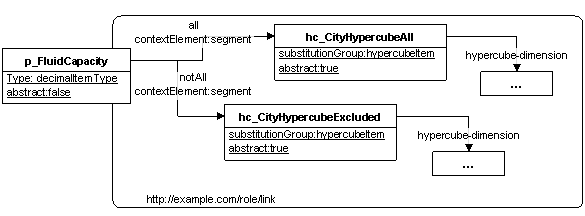
The primary item
declaration p_FluidCapacity is associated with the composition of two
hypercubes in the same base set. A <context> will be valid with respect to the Primary Item only if it has a City reference in its
<segment> that is a member of the hc_CityHypercubeAll and not a member of
hc_CityHypercubeExcluded.
The http://xbrl.org/int/dim/arcrole/all arc role is declared as follows:
The http://xbrl.org/int/dim/arcrole/notAll arc role is declared as follows:
Example 4: A primary item with domain members and a negated hypercube that limits the values for the country dimension of p_CostOfSales by removing m_India from the domain
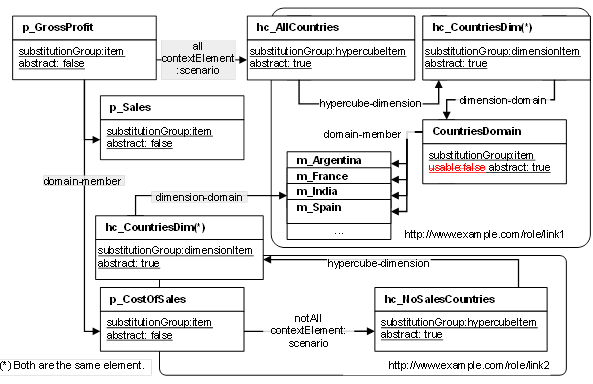
The primary item
declaration p_GrossProfit has two children in the domain-member network.
The valid members in the hc_CountriesDim dimension are {CountriesDomain | m_Argentina |
m_France | m_India | m_Spain} for p_GrossProfit and p_Sales but
p_CostOfSales has only {CountriesDomain | m_Argentina | m_France | m_Spain}
possibilities in the country dimension (m_India has been removed from the domain).
2.3.1.1 Constraints on "all" or "notAll" arcs
- A dimensional processor MUST raise an error xbrldte:HasHypercubeSourceError if the source of an all or notAll arc is not a primary item declaration [Def, 1].
- A dimensional processor MUST raise an error xbrldte:HasHypercubeTargetError if the target of an "all" or "notAll" arc is not a hypercube declaration [Def, 4].
- A
has-hypercubearc MUST have an@xbrldt:contextElementattribute. A dimensional processor MUST raise an error xbrldte:HasHypercubeMissingContextElementAttributeError if this rule is violated.
2.3.2 The required @xbrldt:contextElement attribute on has-hypercube arcs
Every has-hypercube arc MUST have an @xbrldt:contextElement
attribute.
2.3.3 The optional @xbrldt:closed attribute on has-hypercube arcs
The optional Boolean attribute @xbrldt:closed MAY appear on
has-hypercube arcs.
If the @xbrldt:closed attribute is specified with a true value on a
has-hypercube arc with the value <segment> for the
@xbrldt:contextElement attribute, the hypercube is closed with respect to the
<segment> element in that base set.
If the @xbrldt:closed attribute is specified with a true value on a
has-hypercube arc with the value scenario for the
@xbrldt:contextElement attribute, the hypercube is closed with respect to the
<scenario> element in that base set.
[Def, 20] The instantiation of a primary item declaration [Def, 1] as a fact in an instance document is dimensionally valid with respect to a hypercube when:
- For every dimension of the hypercube for which the primary item has a has-hypercube relationship,
either:
- The has-hypercube relationship has xbrldt:contextElement="segment" and the segment dimensional container [Def, 16] of the fact's context has a dimension value [Def, 15] for that dimension, or
- The has-hypercube relationship has xbrldt:contextElement="scenario" and the scenario dimensional container [Def, 16] of the fact's context has a dimension value [Def, 15] for that dimension, or
- The dimension has default value [Def, 17].
[Def, 21] The instantiation of a primary item declaration [Def, 1] as a fact in an instance document is dimensionally valid with respect to a closed hypercube when:
- The fact is dimensionally valid with respect to the hypercube [Def, 20] and
- For every dimension value [Def, 15] in the segment dimensional container [Def, 16] of the fact's context, the dimension of that value is a dimension of the closed hypercube, and
- For every dimension value [Def, 15] in the scenario dimensional container [Def, 16] of the fact’s context, the dimension of that value is a dimension of the closed hypercube.
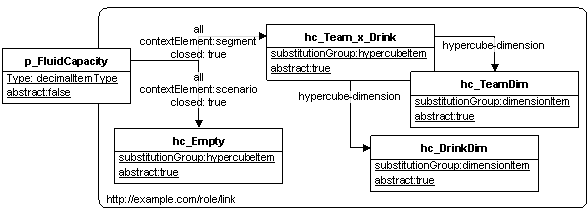
The arcs with xbrldt:closed="true" mean that a <context> is valid with respect
to the target hypercube if it has a Team and Drink and nothing else in the <segment> element,
and nothing at all in the <scenario> element. Note that the all arc to
hc_Team_x_Drink has segment in its @xbrldt:contextElement attribute
and the all arc to hc_Empty has <scenario> in its
@xbrldt:contextElement attribute.
2.4 Partitioning of a Dimensional relationship set across multiple base-sets
Taxonomy authors are able to partition relationships into distinct base sets using the @xlink:role
attribute on extended-type link elements.
However, it is more than a useful feature. In the case of
summation-item relationships in the calculation linkbase, partitioning is essential to ensure
that incompatible summations are not commingled. Taxonomy authors MAY specify distinct
base sets of dimensional relationships that a validating process would apply separately. To forbid this would
violate Requirement P2.
Furthermore, a set of primary item declarations MAY have hypercubes in common among the targets of their has-hypercube
relationships.Hypercube declarations in turn MAY
have typed dimensions in common among the targets of their hypercube-dimension
relationships. In Section 2.5.2 and Section 2.5.3,
additional relationships will also introduce tangled graphs, with some items as the source of separate and
distinct sets of relationships to define different dimensions. If all the dimensional relationships used
together in a validation were forced to be in the same base set, there would be redundancy among dimensional
relationships, violating Requirement P4.
Example 6: When the same dimension must have different domain members, partitioning among different
extended-type link elements and a mechanism to indicate the extended link flow must be implemented.
@xbrldt:targetRole is used for this purpose.
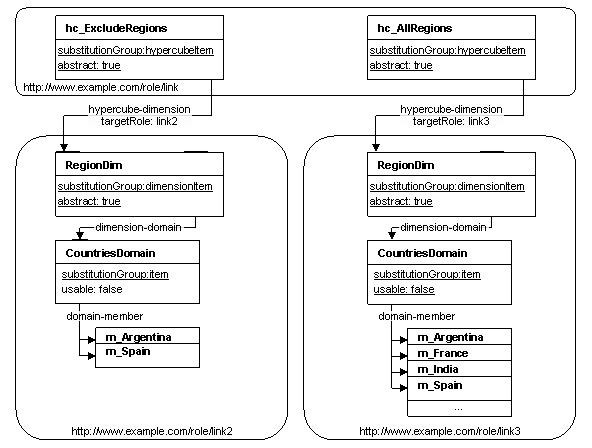
The RegionDim dimension must have different members when it is part of
hc_ExcludeRegions cube and when it is part of the hc_AllRegions cube.
The optional @xbrldt:targetRole attribute on an arc allows a taxonomy author to connect together
two arcs that represent a consecutive relationship [Def,
2] that exist in different roles. As declared in this document, the
@xbrldt:targetRole attribute MAY appear on definition arcs having the
following arc roles: all, notAll, hypercube-dimension,
dimension-domain and domain-member. The @xbrldt:targetRole attribute has
the type anyURI. Resolution of the URI is
not subject to the presence of an @xml:base attribute and its value MUST be an
absolute URI.
[Def, 5] The source role
is the content of the
@xlink:role attribute of the relationship's base set.
In Figure 2 it is identified as role(arc).
[Def, 6] The target role
is the content of the
@targetRole attribute on the arc itself.
In Figure 2 it is identified as targetRole(arc).
Two arcs that represent a consecutive relationship [Def,
2] that exist in different extended-type link elements MUST be connected
together using the @xbrldt:targetRole attribute. Not doing so causes the construction to be
unconnected and results in, for example, empty hypercubes, dimensions and domains.
The @xbrldt:targetRole attribute is optional. If it is present on a relationship, any other relationship that represents a consecutive relationship [Def, 2] in the source role [Def, 5] MUST NOT be considered as part of the dimensional relationship set [Def, 3]. Instead, relationships representing consecutive relationships [Def, 2] in the target role [Def, 6] MUST be considered for the construction of the dimensional relationship set [Def, 3].
| Arc role of Relationship A | Arc role of Relationship B with a source among the targets of Relationship | |||
|---|---|---|---|---|
| all, notAll | hypercube-dimension | Dimension-domain | domain-member | |
| all, notAll | False | role(B) ∈ targetRole(A) | False | False |
| hypercube-dimension | False | False | role(B) ∈ targetRole(A) | False |
| dimension∈domain | False | False | False | role(B) ∈ targetRole(A) |
| domain-member | False | False | False | role(B) ∈ targetRole(A) |
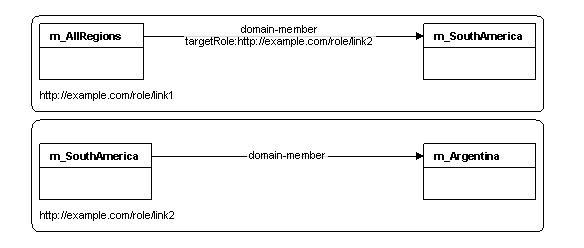
2.4.1 Taxonomy validation impact of splitting dimensional relationship sets
Splitting dimensional relationship sets [Def, 3] into multiple roles impacts the validity of XBRL taxonomies. Consecutive relationships [Def, 2] having the same arcrole MUST NOT violate the cyclesAllowed constraint that would normally apply within in a base set.
The @xbrldt:targetRole attribute itself MUST contain a declared role.
2.4.2 Instance validation impact of splitting dimensional relationship sets
Splitting dimensional relationship sets [Def, 3] into multiple roles does not impact the validity of XBRL instances according to this specification. The rules in Section 3.1 below have the same meaning irrespective of whether the dimensional relationship set [Def, 3] is defined in one role or in multiple roles.
2.4.3 Constraints on the value of a @xbrldt:targetRole attribute
-
If the value, V, of the
@xbrldt:targetRoleattribute on adefinitionArcis not the standard extended link role (http://www.xbrl.org/2003/role/link), the ancestorlinkbaseelement of thedefinitionArcelement MUST have a childroleRefelement (3.5.2.4 [XBRL 2.1]) with V as the value of its@roleURIattribute (5.1.3 [XBRL 2.1]). A dimensional processor MUST raise an error xbrldte:TargetRoleNotResolvedError if this constraint is not satisfied . -
[Def, 19] A consecutive relationship set is the set of
relationships starting at an
allornotAllrelationship, and following all subsequent consecutive relationships [Def, 2]. A dimensional processor MUST raise an error xbrldte:DRSDirectedCycleError for each consecutive relationship set [Def, 19] that contains a directed cycle. - According to the xbrldt XML Schema, the content of the
@xbrldt:targetRoleattribute MUST be a valid URI.
2.5 Dimensions
[Def, 7] A dimension declaration is an abstract item
declaration in the xbrldt:dimensionItem substitution group.
The @xbrli:balance, @xbrli:periodType and @nillable attributes of a dimension
item declaration have no significance.
There are two dimension types in this specification: typed
dimensions and explicit dimensions. The dimension declaration is referenced by using its QName in a
@dimension attribute in the dimension container [Def,
16] element in the <context> elements of XBRL instances. The value of those dimension container [Def, 16] elements MAY be
a QName for explicit dimensions or a complex type XML element
for typed dimensions.
A non empty dimension has a domain of members.
[Def, 8] The domain-of-members is either the instantiation of XML elements according to their XML schema definitions for typed dimensions or the QNames of the members for explicit dimensions.
The domain of elements for typed dimensions is represented by a global element definition in an XML schema. See Section 2.5.2 below.
The domain-of-members for explicit dimensions is composed by traversing the arcs that connect the dimension with the domain and the domain with the members. See section Section 2.5.3 below.
2.5.2 Typed dimensions
[Def, 9] A typed dimension is a dimension declaration [Def, 7] whose domain of members [Def, 8] is defined in another XML element referenced in the @xbrldt:typedDomainRef
attribute.
A typed dimension MUST have nonempty content for the attribute @xbrldt:typedDomainRef.
The @xbrldt:typedDomainRef is an @xlink:href to an element declaration in an XML
Schema that defines the dimension domain.
In the instance document below , a typed dimension value [Def, 15] is the child of an
xbrldi:typedMember element that has a @dimension attribute whose value locates the
typed dimension element declaration.
| Dimension item declaration in tax.xsd | Domain declaration in schema.xsd | Domain members in instance.xbrl |
|---|---|---|
|
<xbrldi:typedMember dimension="tax:dCustomer"> <cust>12345</cust> </xbrldi:typedMember><xbrldi:typedMember dimension="tax:dCustomer">
<cust>01742</cust> </xbrldi:typedMember> |
||
|
Elements valid for the domain type, such as: <xbrldi:typedMember dimension="tax:dPhone"> <phone> </xbrldi:typedMember><country>7</country> <city>7</city> <number>5555555</number> </phone><xbrldi:typedMember dimension="tax:dPhone">
<phone xsi:nil="true"/> </xbrldi:typedMember> |
The separation of the dimension item from the element actually appearing in the instance is necessary because sections 5.2.6, 5.2.6.1 and 5.2.6.2 of the [XBRL 2.1] specification states that relationships in the definition linkbase MAY only have a target in the xbrli:item or xbrli:tuple substitution group, but such a restriction on the domain itself would be neither necessary nor desirable.
2.5.2.1 The @xbrldt:typedDomainRef attribute
The @xbrldt:typedDomainRef attribute is used in a Typed Dimension Element to locate the element in an XML Schema that defines the content of
the typed dimension.
The value of the @xbrldt:typedDomainRef attribute MUST be an URI
reference as defined in [IETF RFC 3986]. The value of @xbrldt:typedDomainRef MUST have a fragment identifier conformant with the section 3.2 of the XPointer
framework [XPOINTER].
The URI referenced in the @xbrldt:typedDomainRef attribute has the type anyURI. If the URI reference is relative,
before use its absolute version MUST
be computed by the method of [XML Base].
The schema pointed to by the xbrldt:typedDomainRef MUST be part of the DTS.
2.5.2.1.1 Constraints on the @xbrldt:typedDomainRef attribute
- A dimensional processor MUST raise an error xbrldte:OutOfDTSSchemaError attribute points to a schema that is not included in the taxonomy DTS.
- A dimensional processor MUST raise an
error xbrldte:TypedDomainRefError if the
@xbrldt:typedDomainRefattribute appears on an XML Schema element declaration that is not a dimension declaration [Def, 7]. - A dimensional processor MUST raise an
error xbrldte:TypedDimensionError if the
@xbrldt:typedDomainRefattribute locates (with@xml:baseand following definition in section 3.2 of [XPOINTER]) any of the following:- Nothing
- Something that is not a global XML Schema element declaration
- A global abstract element declaration.
- A dimensional processor MUST raise an
error xbrldte:TypedDimensionURIError if the
@xbrldt:typedDomainRefattribute does not contain a fragment identifier. - According to the xbrldt XML Schema, the content of the
@xbrldt:typedDomainRefattribute MUST be a valid URI.
2.5.3 Explicit dimensions
[Def, 10] An explicit dimension is a
dimension declaration [Def, 7] that has no @xbrldt:typedDomainRef
attribute and has dimension-domain arcs to zero or more domain member
declarations [Def, 11] whose QNames comprise the dimension domain [Def, 8] .
[Def, 11] A domain member declaration is an element defined in a taxonomy in the xbrli:item
substitution group and not in the xbrldt:hypercubeItem or xbrldt:dimensionItem substitution
groups.
[Def, 12] A domain of valid members of an explicit dimension is the set of QNames of all usable elements (see Section 2.5.3.3 below) in the dimensional relationship set [Def, 3] for the domain-member relation rooted at one domain member [Def, 11]. This is the effective domain [Def, 14] without the elements that are marked as not usable.
The domain members, therefore, inherit all the features of XBRL items, such as labels in multiple languages, presentation ordering, references, and extensibility of relations through prohibition, overrides, and augmentation. The members of the domain MAY also be arranged into a relationship domain-member that satisfies the requirements for an inclusion relationship [Dimensions Requirements].
The domain of an explicit dimension is represented by the target item of a dimension-domain relationship whose source is the explicit dimension element. The QName of the domain item is a valid member of the domain.
According to the architecture defined in Figure 1, Primary Items and explicit
dimension domain members are both in the substitution group of xbrli:item.
A Primary Item defined in a taxonomy can play two different roles
in an instance document: it can be used as a member of an explicit dimension in the
<context> of another item or it can be used as an item. The QName of a primary item MUST NOT be a member of the domain of any
of its explicit dimensions.
2.5.3.1 Arc role http://xbrl.org/int/dim/arcrole/dimension-domain
A dimension-domain relationship has an explicit dimension declaration [Def, 10] as its source and any domain member declaration [Def, 11] as its target. It binds a dimension to a domain.
The @xbrli:balance, @xbrli:periodType and @nillable attributes of a domain
declaration have no significance.
The arc MAY have a nonempty @xbrldt:usable attribute as stated in
Section 2.5.3.3 below.
The http://xbrl.org/int/dim/arcrole/dimension-domain arc role is declared as follows:
2.5.3.1.1 Constraints on the dimension-domain arcs
- A dimensional processor MUST raise an error xbrldte:DimensionDomainSourceError if the source of the arc is not an explicit dimension declaration [Def, 10].
- A dimensional processor MUST raise an error xbrldte:DimensionDomainTargetError if the target of the arc is not a domain member declaration [Def, 11].
- A dimensional processor MUST raise an error xbrldte:PrimaryItemPolymorphismError if there is a cycle in which the Primary Item source of the hypercube is also a member of the domain of valid members [Def, 12].
2.5.3.2 Arc role http://xbrl.org/int/dim/arcrole/domain-member
A domain-member relationship binds a domain to a member of a domain. The purpose of this relationship is to create sets of explicit domain members.
[Def, 13] A dimension domain for explicit dimensions is the set of QNames of domain member declarations [Def, 11] in the dimensional relationship set [Def, 3] rooted at the target of a dimension-domain arc and connected together with domain-member arcs.
The base set of a domain-member relationship MAY have undirected cycles but MUST NOT have directed cycles.
The http://xbrl.org/int/dim/arcrole/domain-member arc role is declared as follows:
2.5.3.2.1 Constraints on the domain-member arcs
- A dimensional processor MUST raise an error xbrldte:DomainMemberSourceError if the source of a domain-member arc is not a primary item declaration.
- A dimensional processor MUST raise an error xbrldte:DomainMemberTargetError if the target of a domain-member arc is not a primary item declaration.
- A dimensional processor MUST raise an error xbrldte:PrimaryItemPolymorphismError if there is a cycle in which the Primary Item source of the hypercube is also a member of the domain of valid members [Def, 12].
2.5.3.3 The optional @xbrldt:usable attribute
The @xbrldt:usable attribute is used to denote domain members that MUST NOT
not be used as values of a domain in an instance document. This allows members to be introduced
into the domain member hierarchy for the purpose of organising the hierarchy.
The @xbrldt:usable attribute MAY appear on
http://xbrl.org/int/dim/arcrole/dimension-domain arcs or on
http://xbrl.org/int/dim/arcrole/domain-member arcs.
The default value of the @xbrldt:usable attribute is true.
If an arc has an @xbrldt:usable attribute whose value is false, its targets are excluded from the domain of valid members.
The exclusion does not affect subsequent children in the domain-member DRS rooted at the excluded element.
[Def, 14] The effective domain of a dimension is the union of all dimension domains [Def, 13] declared using dimension-domain arcs that exist for a particular dimension in the dimensional relationship set [Def, 3].
If during the evaluation of the domain of valid members of an explicit dimension [Def, 12] within the effective domain [Def, 14] of the dimension the same member had
xbrldt:usable=false in one dimension domain [Def,
13] and xbrldt:usable=true in another dimension domain [Def, 13] the member MUST be considered as effectively
excluded from the domain of valid
members of an explicit dimension [Def, 12].
2.6 Domain-member relations and inheritance
A primary item declaration MAY
be the source of a domain-member relationship. When a primary item declaration is the source of both a domain-member relationship and a
has-hypercube relationship, the target of the domain-member
relationship is said to inherit the has-hypercube relationship of the source element. Inheritance
is transitive. Inheritance preserves the base set and DRS of the original has-hypercube
relationship, as well as the values of its @xbrldt:contextElement attribute and @xbrldt:closed attribute.
The example below shows two primary item declarations that have a common ancestor from which they inherit an all relation to a hypercube.
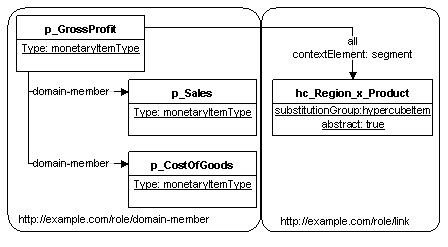
|
primary item declarations They are all roots of the same dimensional base sets. |
A primary item declaration having no direct
has-hypercube relationships MAY inherit any number of has-hypercube
relationships from its parents in the domain-member
network.
The impact of has-hypercube relationships on instance validation is unchanged merely because
the relationships have been inherited.
2.6.1 Processing of multiple has-hypercube arcs
In Example 6 above, the domain-member network created with elements from the primary taxonomy MAY have multiple has-hypercube arcs at different levels of the tree.
As stated in Section 3.1.2, "Mutual validity of hypercbues in a base set" below , only hypercubes that are found within the same base set are considered together for validation.
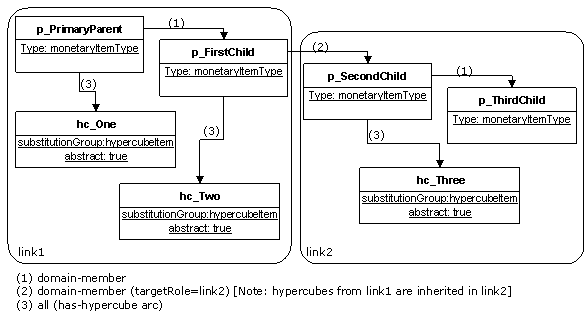
| Element under validation | Extended link | Hypercubes |
|---|---|---|
| p_PrimaryParent | link1 | hc_One |
| p_FirstChild | link1 | hc_One and hc_Two |
| p_SecondChild | link1 | hc_One and hc_Two |
| p_ThirdChild | link1 | hc_One and hc_Two |
| p_PrimaryParent | link2 | None |
| p_FirstChild | link2 | None |
| p_SecondChild | link2 | hc_Three |
| p_ThirdChild | link2 | hc_Three |
Hypercube inheritance is across the entire dimensional relationship set [Def, 3] of the domain-member network.
In Example 12 below there is another example of this particular use case:
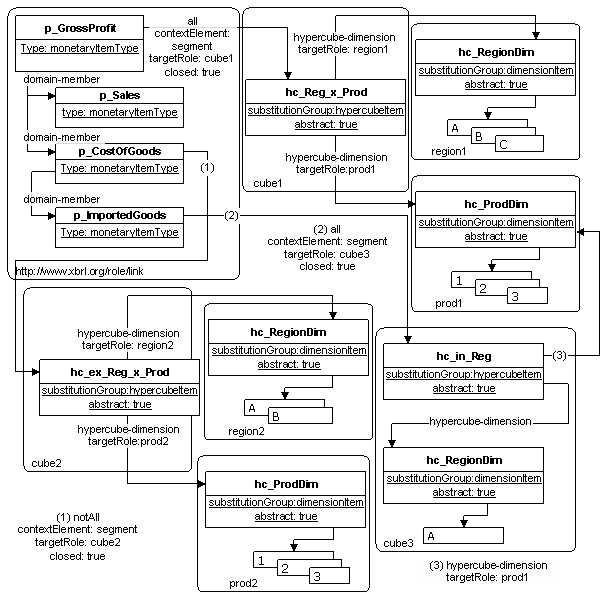
This is the table of the possible values for each Primary Item:
| Element | Product Dimension | Region Dimension | Explanation |
|---|---|---|---|
p_GrossProfit
|
1,2,3 | A,B,C | Directly linked hypercube hc_Reg_x_Prod defined in cube1 |
p_Sales
|
1,2,3 | A,B,C | Inherited from parent p_GrossProfit
|
p_CostOfGoods
|
1,2,3 | C | Inherited from parent is cube1, but cube2 with notAll excludes combinations of A,B with all members from the product dimension and keeps element C from the regions dimension combined with all members in the product dimension |
p_ImportedGoods
|
1,2,3 | No combination is possible, a warning MAY be raised by dimensional processors. | Inherited from parent p_CostOfGoods are only the combinations of the C region with
all members in the products domain. cube3 is incompatible because it only includes region A. Either
hypercube declared in (cube1 and not cube2) or hypercube declared in (cube3) will be invalid so the
hypercubes are not compatible and it is not possible to create a dimensionally valid instantiation
of p_ImportedGoods. |
The order in which the has-hypercubes arcs are processed is not relevant to the result.
2.7 Default values for dimensions
Dimensions are allowed to have default values.
The dimension-default relationship specifies which domain member plays the role of the default member for that dimension.
The default values for dimensions are automatically inferred by
dimensional processors and MUST NOT appear in the <context> of an instance
(see Section 3.1.4.1).
The automatic inference of default values for dimensions
MAY be used in taxonomies to allow summation-item or other relationships
between some specific facts reported without a particular dimension.
In the tx taxonomy only the GrossProfit primary concept has a products
dimension, and the default member in the products dimension is the p:TotalProducts
member. A calculation network exists in the primary taxonomy tx to represent that NetProfit =
GrossProfit – Taxes. The concept GrossProfit for
TotalProducts (the one with @contextRef = "ctx1") is dimensionally
valid (ProductDim = p:TotalProducts) and used in summation-items relationships
with Taxes and NetProfit.
2.7.1 Arc role http://xbrl.org/int/dim/arcrole/dimension-default
The dimension-default arc role identifies in its source a dimension element and in its target
the default member.
The default member indicated in the target of a dimension-default arc is global. If one dimension-default arc exists in one extended link, then the default member is considered as defined in all the extended links where the dimension is used and the domain contains the domain member indicated in the target of the arc.
The dimension-default relationship is not subject to the effect of the
@xbrldt:targetRole attribute.
The existence of a dimension-default arc does not add the target item to any of the domains
of the source dimension.
The http://xbrl.org/int/dim/arcrole/dimension-default arc role is declared as follows:
2.7.1.1 Constraints on dimension-default arcs
- A dimensional processor MUST raise an error xbrldte:DimensionDefaultSourceError if the source of the arc is not an explicit dimension declaration [Def, 10].
- A dimensional processor MUST raise an error xbrldte:DimensionDefaultTargetError if the target of the arc is not a domain member declaration [Def, 11].
- A dimension MUST NOT have more than one default member. A dimensional processor MUST raise an error xbrldte:TooManyDefaultMembersError if this rule is violated.
3 Dimensions in instance documents
Primary taxonomies define the concepts that will be used to represent the facts in a XBRL instance document.
An instance document whose DTS contains dimensional relationships according to this specification MUST be validated using the rules defined in this specification.
NON NORMATIVE NOTE: The validation of the instance document must be made item by item. A dimensional processor
must find the hypercubes related to an item in the document DTS and must validate the hypercubes one by one. One
hypercube is valid if all its dimensions are valid. A dimension is valid if in the <context> there is
a member of its domain or if the dimension contains a default member. The result of the hypercubes validation
must be combined for those hypercubes that coexist in the same base set using the specified operator "all",
"notAll". One Primary Item is valid if it is not associated with any hypercube or if there is at least one extended link role in which the primary item is associated to a combination of hypercubes whose combined validation result is valid.
The following sections describe in more detail the rules that apply to the validation of every dimensional component.
3.1 Validation of primary items
Every primary item [Def, 1] that has hypercubes in the DTS of the instance document MUST be valid according to at least one of the base sets in which its hypercubes are defined.
A primary item declaration [Def, 1] is the root of a
dimensional relationship set [Def, 3] in a base
set when the base set contains at least one has-hypercube relation (all, notAll) whose source is
that primary item declaration [Def, 1].
When a primary item declaration [Def, 1] is the root of a base set, it is also the root of the dimensional relationship set [Def, 3] of that base set.
A dimensionally valid Primary Item instantiation MUST
be either the source of no dimensional
relationship set [Def, 3], or the root of a dimensional relationship set [Def, 3] in which its <context> is dimensionally valid.
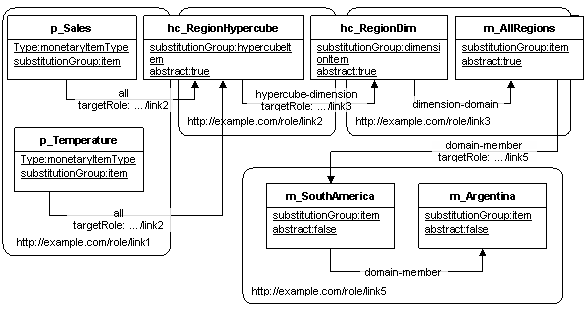
Primary item declaration [Def,
1] p_Sales is the root of the dimensional relationship set that includes, among
others, all arcs in base set http://example.com/role/link3.
Whether a primary item declaration [Def, 1] appears
inside a tuple has no relevance to whether its Primary Item
instantiation and <context> are dimensionally valid.
Primary Items are dimensionally valid if the hypercubes found in at least one base set are mutually valid.
3.1.1 Constraints on the validity of primary items
- A Primary Item is dimensionally valid if the hypercubes found in at least one base set are mutually valid. See Section 3.1.2. A dimensional processor MUST raise an error xbrldie:PrimaryItemDimensionallyInvalidError if the hypercube combinations found in all base sets are invalid.
3.1.2 Mutual validity of hypercubes in a base set
A Primary Item is valid according to the hypercubes defined in a base set if the operation that joins all the hypercubes is satisfied.
Figure 3 below shows the warnings that a dimensional processor MAY raise when a primary item is not valid according to its hypercubes and the operation that combines multiple hypercubes within the same base set.
| Nº of cubes | Operator | Hypercube(s) evaluation | Primary Item eval. Result | Warning |
|---|---|---|---|---|
| 1 | all | Valid | Valid | No error |
| 1 | notAll | Invalid | Valid | No error |
| 2 | all notAll |
Valid Invalid |
Valid | No error |
| 1 | all | Invalid | Invalid | There is just one hypercube and is invalid for the all operation |
| 1 | notAll | Valid | Invalid | There is just one hypercube and is valid for the notAll operation |
| 2 | all notAll |
Valid Valid |
Invalid | There are multiple hypercubes defined in a base set and the result of the combination invalid |
3.1.3 Individual validity of hypercubes
| Closed | Empty | Dimensions | dimension values | Dimension validity | Result |
|---|---|---|---|---|---|
| Yes | Yes | N/A | None | N/A | Valid |
| No | Yes | N/A | N/A | N/A | Valid |
| Yes | Yes | N/A | Dimension values found | N/A | Invalid |
| Yes | No | Dim1 and Dim2 | Dimension value found for Dim1 and Dim2 | Dim1 OK and Dim2 OK | Valid |
| Yes | No | Dim1 and Dim2 | Dimension value found for Dim1 and Dim2 and Dim3 (Note 1) | N/A | Invalid |
| Yes | Yes | Dim1 and Dim2 | Dimension value found for Dim1 and Dim2 and Dim3 (Note 2) | Dim1 OK and Dim2 OK and Dim3 N/A | Valid |
| Yes | Yes | Dim1 | Dimension value not found for Dim1 | N/A | Invalid |
| Yes | Yes | Dim1 | Dimension value found for Dim1 | Dim1 NOT OK | Invalid |
All dimensions in a hypercube MUST be validated according to rules defined in Section 3.1.4.
Note 1: Invalid because the hypercube is closed and Dim3 is not expected.
Note 2: This hypercube is open, so Dim3 is allowed.
3.1.3.1 Constraints on the individual validity of hypercubes
- A closed hypercube MUST NOT contain unexpected dimension values. If a closed hypercube contains any unexpected dimension value the hypercube is invalid.
- There MUST be a dimension value
in the container indicated in the value of the
@xbrldt:contextElementattribute in thehas-hypercubearc. If there is no value for the dimension in the indicated container the hypercube is invalid. - All dimensions defined in the hypercube MUST be valid according to the rules defined in Section 3.1.4 "Validity of dimensions" below. If one dimension is invalid the hypercube is invalid.
3.1.4 Validity of dimensions
[Def, 15] The dimension value is defined as the
QName that is the content value of the explicit dimension
container [Def, 16] for explicit dimensions or the XML fragment that is the first child element of the typed dimension container [Def, 16] for typed dimensions. A dimension value [Def, 15]
exists for one specific dimension in one of the two possible <context>
containers: <segment> or <scenario> . The default values are also possible dimension values but they are not enclosed in dimension
containers [Def, 16] .
[Def, 16] The dimension container is the element
xbrldi:typedMember for typed dimensions or the element
xbrldi:explicitMember for explicit dimensions.
A dimension value MUST be valid according to its Domain. Validation of typed dimensions and explicit dimensions is defined in Section 3.1.4.4 below and Section 3.1.4.5 below respectively.
3.1.4.1 Obtaining the dimension value for a dimension
A dimensional processor MUST be able to obtain from the <segment> or
<scenario> element the value reported for a typed or explicit dimension.
The dimension value content [Def, 15] for typed dimensions is the content of the
xbrldi:typedMember element whose @dimension attribute value is the QName of the
dimension in use.
The dimension value [Def, 15] for explicit dimensions is the QName that is the content of the
xbrldi:explicitMember element whose @dimension attribute value is the QName of
the dimension in use or the QName of the default member if the value is not reported in the instance and
the dimension has a default member.
[Def, 17] The default value is the QName of the default member.
3.1.4.2 Constraints about dimension values
- A
<context>MUST NOT contain more than one dimension value [Def, 15] for each dimension. A validator MUST signal an error xbrldie:RepeatedDimensionInInstanceError when this rule is violated. - According to Section 2.7.1.2 above a dimension the default values [Def, 17] cannot appear in the instance document and an error xbrldie:DefaultValueUsedInInstanceError MUST be raised if the default value is found.
3.1.4.3 Examples of context and their dimension validity


Missing a reference to the Drink dimension. |
|
Missing a reference to the Team dimension. |
| Dimensions | Domains | Member | Result |
|---|---|---|---|
| RegionDim | r:Europe, r:Asia, r:Africa, r:SouthAmerica | r:Europe | Valid (member is in the domain) |
| RegionDim | r:Europe, r:Asia, r:Africa, r:SouthAmerica p:Wine, p:Cars, p:Other | r:Japan | Invalid (member is not in the domain) |
| RegionDim and ProductDim | r:Europe, r:Asia, r:Africa, r:SouthAmerica p:Wine, p:Cars, p:Other | p:Wine | Invalid (missing value for the Region Dimension) xbrldie:PrimaryItemDimensionallyInvalidError MUST be raised |
| RegionDim and ProductDim | r:Europe, r:Asia, r:Africa, r:SouthAmerica p:Wine, p:Cars, p:Other | r:Japan | Invalid (missing value for the Products Dimension) xbrldie:PrimaryItemDimensionallyInvalidError MUST be raised |
| RegionDim and ProductDim | r:Europe, r:Asia, r:Africa, r:SouthAmerica p:Wine, p:Cars, p:Other | r:Africa p:Soja | Invalid (member is not in the product domain) |
| RegionDim and ProductDim | r:Europe, r:Asia, r:Africa, r:SouthAmerica p:Wine, p:Cars, p:Other | r:Africa p:Cars | Valid (members are in the Region and Product domains) |
Example 19: Primary items that are not dimensionally valid because they violate their hypercube constraints
|
<context id="c19">
<entity> <identifier scheme="http://nic.net">example.com</identifier> <segment> </entity><xbrldi:explicitMember dimension="p:ProductDim">p:m_RedWine</xbrldi:explicitMember> <xbrldi:explicitMember dimension="p:RegionDim">p:m_Barbados</xbrldi:explicitMember> </segment><period> </context><forever/> </period><p:p_GrossProfit contextRef="c19" unitRef="eur" decimals="INF">10000</p:p_GrossProfit> <p:p_CostOfGoods contextRef="c19" unitRef="eur" decimals="INF">50000</p:p_CostOfGoods> <p:p_Sales contextRef="c19" unitRef="eur" decimals="INF">60000</p:p_Sales>
|
Assuming the context is using the DRS defined in
Example 10 and Example 20.
p:m_
Barbados is not a domain member of
RegionDim;
hence the constraint is violated by all three facts even though only p_Sales
had an explicit "all" arc to hc_Product_x_Region.
|
3.1.4.4 Typed dimensions
The member of a typed dimension is the instantiation of an
element that conforms to the element referenced in the @xbrldt:typedDomainRef attribute of a
typed dimension declaration [Def, 9].
3.1.4.4.1 The xbrldi:typedMember element
The xbrldi:typedMember element is an XML element whose content MUST
be another element whose schema declaration is located by the @xbrldt:typedDomainRef attribute
(see section Section 2.5.2.1).
The content of the @dimension attribute of an xbrldi:typedMember element
MUST resolve to the QName of a typed
dimension declaration [Def, 9] within the DTS of the instance.
A typed dimension is valid if the dimension value [Def, 15] is XML valid according to the schema
declaration referred to in the @xbrldt:typedDomainRef attribute.
Not all of the elements appearing in <segment> or <scenario> are necessarily
dimension elements; see section Section 2.3.2.1 regarding the
@closed attribute.
3.1.4.4.2 Constraints about the @dimension attribute in xbrldi:typedMember elements
- The content of the
@dimensionattribute of anxbrldi:typedMemberelement MUST be the QName of a typed dimension declaration [Def, 9] defined in a schema within the DTS of the instance document. A dimensional processor MUST raise an error xbrldie:TypedMemberNotTypedDimensionError if the element whose QName appears in the@dimensionattribute ofxbrldi:typedMemberresolves to anything other than a typed dimension declaration [Def, 9].
3.1.4.4.3 Constraints on the content of xbrldi:typedMember elements
- According to the
xbrldiXML Schema, every instance ofxbrldi:typedMemberMUST have only one child element. - The typed dimension value [Def, 15] MUST be XML valid according to the XML Schema declaration of the element
referenced in the
@xbrldt:typedDomainRefattribute. - The typed
dimension content [Def, 15]
MUST be an instantiation of the element pointed to by the
@xbrldt:typedDomainRefof the typed dimension indicated in the@dimensionattribute of thexbrldi:typedMemberelement. A dimensional processor MUST raise an error xbrldie:IllegalTypedDimensionContentError if this rule is violated.
3.1.4.5 Explicit dimensions
The member of an explicit dimension is the QName that
is the content of the xbrldi:explicitMember element. It MUST be a
valid member of the explicit
dimension [Def, 12].
3.1.4.5.1 The xbrldi:explicitMember element
The xbrldi:explicitMember element is an XML element whose content MUST
be a QName. The explicit dimension is valid
if the dimension value [Def, 15] (QName) is a valid member of the explicit dimension
domain [Def, 12] to which its @dimension attribute refers.
Example 22: A context that is dimensionally valid with respect to a hypercube with two explicit dimensions
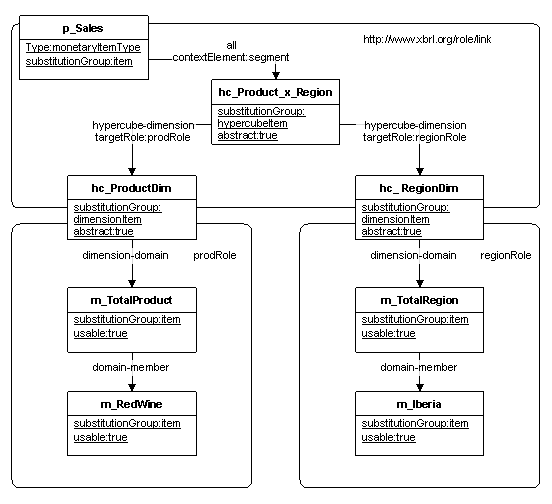
3.1.4.5.2 Constraints on the @dimension attribute in xbrldi:explicitMember
elements
- The content of the
@dimensionattribute of anxbrldi:explicitMemberelement MUST be the QName of an explicit dimension element defined in a schema within the DTS of the instance document. A dimensional processor MUST raise an error xbrldie:ExplicitMemberNotExplicitDimensionError if the element whose QName appears in the@dimensionattribute ofxbrldi:explicitMemberresolves to anything other than an explicit dimension declaration [Def, 10].
3.2 Definition of dimensionally equal facts
[Def, 18] Two facts are d-equal for one dimension if they have the same dimension value [Def, 15] for that dimension.
d-equal
is an independent operation of
c-equal, u-equal, s-equal defined in section 4.10 of [XBRL 2.1].
d-equal
is defined only for two facts and one dimension.
Two dimension values [Def, 15] are the same when they are
s-equal2. Two facts have the same dimension if both have a dimension container whose content of the @dimension
attribute are s-equal2 and both refer to the same dimension declaration [Def, 7].
The s-equal2 operation is the same operation defined in section 4.10 of [XBRL 2.1]
replacing XPATH 1.0 with XPATH 2.0 in the definition of the x-equal
operation and with the "XPath 1.0 compatibility mode" property set to false in the static
<context> (See the implementation note below).
In order to allow the summation-item relationships defined in section 5.2.5.2 of [XBRL 2.1] to work, all dimensional elements (xbrldi:explicitMember and
xbrldi:typedMember) found in the <segment> or <scenario> container of the
<context> MUST be s-equal as defined in the section 4.10 of [XBRL 2.1].
IMPLEMENTATION NOTE: [XBRL 2.1] is based on [XPath 1.0]. According to section 5.3 of
[XPath 1.0], the content of attributes is always a string-value rather than a QName. XBRL APIs
implementing dimensions should take care of this and normalise the prefixes of QNames that appear in the
@dimension attribute of the dimension container
and in the content of the dimension container within the
instance document.
Two facts related to different <context> s that appear in different instances MAY
be d-equal for all dimensions regardless of the order in
which the elements appear inside the <segment> or the <scenario> .
| Fact Sales in Context A | Fact Sales in Context B | d-equal( Sales, prodDim) |
|---|---|---|
|
<segment>
<xbrldi:explicitMember dimension="tax:prodDim">p:product</xbrldi:explicitMember> </segment> |
<segment>
<xbrldi:explicitMember dimension="tax:prodDim"> p:product</xbrldi:explicitMember> </segment> |
Yes. Note the spaces between elements are different. |
|
<segment>
<xbrldi:explicitMember dimension="tax:prodDim">p:product</xbrldi:explicitMember> <xbrldi:explicitMember dimension="tax:dept_dim">r:sales</xbrldi:explicitMember> </segment> |
<segment>
<xbrldi:explicitMember dimension="tax:dept_dim">r:sales</xbrldi:explicitMember> <xbrldi:explicitMember dimension="tax:prodDim">p:product</xbrldi:explicitMember> </segment> |
Yes. Note that the order of the two explicit elements is different. According to the text in this
section these two |
|
<segment>
<xbrldi:explicitMember dimension="tax:prodDim">p:product</xbrldi:explicitMember> </segment> |
<scenario>
<xbrldi:explicitMember dimension="tax:prodDim">p:product</xbrldi:explicitMember> </scenario> |
No, Dimensions MUST be reported in the same container type. |